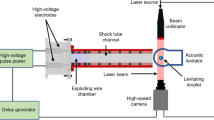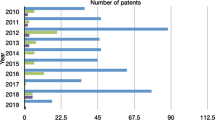Abstract
The mechanism of formation of polymer nanoparticles prepared by the emulsification-diffusion method was evaluated under different preparation conditions and by turbidimetry measurements. Biodegradable poly (D,L-lactic acid) was used as the polymer model. The results show that each emulsion droplet will form several nanoparticles and that the interfacial phenomena during solvent diffusion determine the size properties of the resulting colloid particles. These phenomena cannot be entirely explained by the convection effects caused by interfacial turbulence. We suggest that nanoparticle formation is due to diffusion alone, and we propose a mechanism based on the “diffusion-stranding” mechanism for spontaneous emulsification. In this mechanism, the diffusion of solvent causes local supersaturation near the interface, and nanoparticles are formed, due to the phase transformation and polymer aggregation that occur in these regions. This interpretation is supported by the turbidity measurements made at different polymer concentrations and stirring rates.
Similar content being viewed by others
References
Allémann E, Gurny R, Doelker E (1993) Eur J Pharm Biopharm 39:173–191
Couvreur P, Dubernet C, Puisieux F (1995) Eur J Pharm Biopharm 41:2–13
Gurny R (1983) In: Breimer DD, Speiser P (eds) Topics in Pharmaceutical Sciences. Elsevier, Amsterdam, pp277–288
Gallardo MM, Roblot-Treupel L, Mahuteau J, Genin I, Couvreur P, Plat M, Puisieux F (1989) Nanocapsules et nanosphères d’alkyl-cyanoacrylate, interactions principe actif/polymère. Proc APGI, 5th Int Conf on Pharmaceutical Technology, Paris (France) pp 36–45
Leroux JC, Allémann E, Doelker E, Gurny R(1995) Eur J Pharm Biopharm 41:14–18
Quintanar-Guerrero D, Allémann E, Fessi H, Doelker E(1996) Int J Pharm 143:133–141
Sánchez A, Vila-Jato JL, Alonso MJ (1993) Int J Pharm 99:263–273
Elving PJ, Winefordner JD (1982) In: Chemical Analysis. Wiley, New York, pp255–257
El-Aasser M (1979) In: Advances in Emulsion Polymerization and Latex Technology. Vol 2. Lehigh University, Bethleem, Pennsylvania, No.19
Sterning CV, Scriven LE (1959) AIChEJ 5:514–523
Molpeceres J, Guzman M, Aberturas MR, Chacon M, Berges L (1996) J Pharm Sci 85:206–213
Fessi H, Puisieux F, Devissaguet JP, Ammoury N, Benita S (1989) Int J Pharm 55:R1-R4
Fessi H, Devissaguet JP, Puisieux F, Thies C (1988) French Pat 2608 988
Davies JT, Rideal EK (1961) In: Interfacial Phenomena. Academic Press, New York, pp319–326, pp 359-366
Stainmesse S, Orecchioni AM, Nakache E, Puisieux F, Fessi H (1995) Colloid Polym Sci 273:505–511
Dimitrova B, Ivanov YB, Nakache E (1988) Disp Sci Tech 9:321–341
Tadros TF (1979) J Colloid Interface Sci 72:505–514
Ruschak KJ, Miller CA(1972) Ind Eng Chem Fundam 11:534–540
Author information
Authors and Affiliations
Rights and permissions
About this article
Cite this article
Quintanar-Guerrero, D., Allémann, E., Doelker, E. et al. A mechanistic study of the formation of polymer nanoparticles by the emulsification-diffusion technique. Colloid Polym Sci 275, 640–647 (1997). https://doi.org/10.1007/s003960050130
Received:
Accepted:
Issue Date:
DOI: https://doi.org/10.1007/s003960050130




